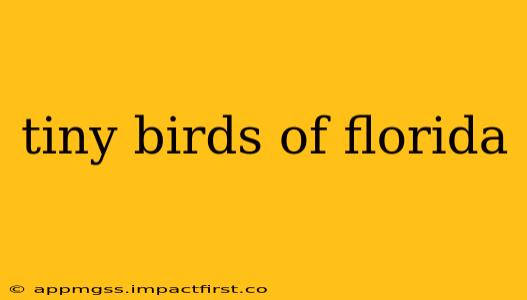Florida's diverse ecosystem boasts a vibrant array of bird species, many of which are surprisingly small. Identifying these tiny treasures can be a rewarding challenge for birdwatchers of all levels. This comprehensive guide delves into the world of Florida's smallest birds, exploring their unique characteristics, habitats, and behaviors. We'll cover identification tips, where to spot them, and answer some frequently asked questions.
What are some of the smallest birds in Florida?
Several species vie for the title of "smallest bird in Florida," depending on how you measure (weight versus length). However, consistently among the tiniest are:
- Golden-crowned Kinglet: This tiny powerhouse packs a punch with its bright yellow crown and constant flitting motion. It's a common winter visitor, often found foraging in trees and shrubs.
- Ruby-crowned Kinglet: A close relative of the Golden-crowned, the Ruby-crowned Kinglet is slightly larger but still incredibly small. Its hidden ruby-red crown patch is only visible when it's excited or alarmed.
- Brown Creeper: This inconspicuous bird is known for its spiraling ascent up tree trunks, searching for insects in the bark. Its small size and cryptic coloration make it challenging to spot.
- House Wren: While not the absolute smallest, the House Wren is undeniably tiny and a very common backyard bird, making it a frequent sighting for Floridians. Their loud, bubbly songs are easily recognizable.
- Hummingbirds (various species): Florida boasts several hummingbird species, all of which are exceptionally small and known for their incredible hovering abilities. Their diminutive size and rapid wing beats make them a captivating sight.
How can I identify small birds in Florida?
Identifying small birds requires patience and keen observation. Here are some key strategies:
- Focus on size and shape: Compare the bird to familiar objects, such as your finger or a coin, to get a sense of scale. Note the bird's overall shape – is it round, slender, or long-tailed?
- Observe plumage: Pay close attention to the bird's color, pattern, and markings. Even subtle differences can be crucial for identification. Use binoculars for a closer look.
- Listen to their songs: Many small birds have distinctive vocalizations. Learning to recognize their songs can greatly aid identification. Use a bird song identification app to help you.
- Note the habitat: Different birds prefer different habitats. Knowing the bird's environment (e.g., forest, scrub, wetland) can narrow down the possibilities.
- Consult field guides: Keep a reputable Florida bird guide handy. Detailed illustrations and descriptions are invaluable for identification.
What are the best places to see tiny birds in Florida?
Florida’s diverse habitats offer excellent opportunities for spotting tiny birds. Some prime locations include:
- State Parks and Wildlife Management Areas: These protected areas often have diverse ecosystems and abundant birdlife.
- National Wildlife Refuges: Refuges provide essential habitat for many bird species, including smaller varieties.
- Urban Parks and Gardens: Surprisingly, even urban areas can attract smaller birds, especially those with native plantings.
- Backyards: Attract tiny birds to your backyard by providing food sources (like nectar feeders for hummingbirds and seed feeders for other small birds), water sources, and suitable nesting habitats.
What do tiny birds in Florida eat?
The diet of tiny Florida birds varies greatly depending on the species. However, common food sources include:
- Insects: Many small birds are insectivores, feeding on a variety of insects and spiders.
- Nectar: Hummingbirds are specialized nectar feeders, sipping nectar from flowers.
- Seeds: Some small birds consume seeds, particularly during the winter months when insects are scarce.
- Fruit: Certain species supplement their diet with small fruits.
Are tiny birds in Florida migratory?
Many of Florida's tiny birds are migratory, spending the winter months in the state and breeding further north during the warmer seasons. Others are year-round residents. The migratory patterns of specific species are important to note for successful birding.
What threats do tiny birds in Florida face?
Tiny birds, due to their small size and vulnerability, face numerous threats:
- Habitat loss: The destruction of natural habitats due to development and urbanization is a major threat.
- Predation: Small birds are prey for larger birds, snakes, and other animals.
- Pesticides: Exposure to pesticides can be harmful or even fatal.
- Climate change: Changes in climate can disrupt migration patterns and food sources.
By understanding the characteristics, habitats, and challenges faced by Florida’s tiny birds, we can appreciate these remarkable creatures and work to protect their fragile ecosystems. Happy birding!
